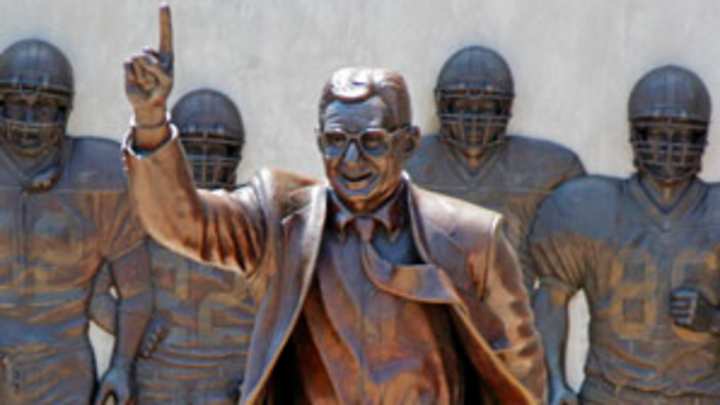Statues have been erected outside stadiums since Roman Empire


In the forecourt of his palace, the Roman emperor Nero kept a statue of himself, 10 stories tall. The Colossus of Nero, as it came to be known, was 120 feet of upright bronze, self-commemorating a tyrant who had -- among other acts of depravity -- murdered his own mother. The statue was eventually moved to a spot outside the Flavian Amphitheatre, which became known, by its proximity to the Colossus, as the Colosseum.
Two thousand years later, as the statue of Joe Paterno metaphorically overshadows Beaver Stadium at Penn State, it's worth remembering that men have been erecting statues outside stadiums since antiquity, often in tribute to living figures, and often as monuments to hubris rather than integrity.
Paterno himself must have known this, having frequently spoken of the profound effect Virgil's Aeneid had on his life. The Aeneid, the epic poem of the Roman Empire, was about a man -- the Trojan Prince Aeneas -- "whose fate has made him a fugitive."
Joe Paterno, of course, is no Nero, except as an easy analogy, fiddling while Rome burned. But both men are among countless examples, over two millennia, of the folly of erecting statues to the living.
As objects of veneration, statues have long been self-commissioned and self-aggrandizing: In the first century, Caligula commissioned a golden statue of himself that was dressed daily in whatever he happened to be wearing. In the 20th century, Turkmenistan dictator Saparmurat Niyazov ordered a golden statue of himself, 39 feet tall, that rotated 360 degrees every 24 hours so that the sun always shone on his face.
Quite how statues of living people came to be seen as appropriate honors despite religious proscriptions against graven images isn't clear. But it does make for some awkward dedication ceremonies. "It's not about me, it's about Jesus Christ," Albert Pujols said last November at the unveiling of a 10-foot-tall statue of himself, outside a St. Louis restaurant named for himself, one month before he left St. Louis for Anaheim for a quarter of a billion dollars, at which time his statue was given its own security guard, lest it be toppled like one of Saddam Hussein's.
But as such statues have become a Borat-ian symbol of excess -- the Manchester United star Nani had to deny to the BBC that he keeps a marble statue of himself in his living room -- they have, paradoxically, only become more popular. So much so that sport has entered its Bronze Age. Statues of living athletes and other celebrities proliferate as never before, though few of them will be mistaken for the Lincoln Memorial.
The statue of baseball commissioner Bud Selig outside Miller Park is a short drive from the statue of Arthur Fonzarelli -- "The Bronze Fonz" -- in downtown Milwaukee. A 900-pound Shaquille O'Neal on the LSU campus was unveiled last September by its 350-pound inspiration. When Thierry Henry scored on his return to Arsenal in January, his statue outside the Emirates Stadium was already celebrating for him. (Across town in London, Michael Jackson stands in perpetual one-gloved wonder outside Fulham Football Club's aptly-named ground: Craven Cottage.)
Most ballparks are now backdrops for statues of living stars, some of whom -- Jeff Bagwell and Craig Biggio spring to mind -- retired in the last half-hour. So ubiquitous are such statues that Kareem Abdul-Jabbar expressed his disappointment last year that the Lakers had not yet erected a statue of him, as they'd already done for Magic Johnson, Jerry West and broadcaster Chick Hearn. Indeed, the statue of Wayne Gretzky outside the Staples Center ensures that bronze Gretzkys outnumber the real one, as the Great One was already on a plinth outside the Edmonton Oilers' arena.
But then there are multiple Ty Cobbs, sundry Secretariats, a panoply of Peles on which pigeons might alight. Amid America's manifold monuments to Washington and Jefferson and Franklin are statues of Larry Holmes, Harry Caray, Vince Lombardi, Rocky Balboa, Arnold Palmer and endless other sportsmen real and mythical and, more often, something in between.
It's difficult to argue that statues still give gravitas to their subjects when we can pose, in the space of an afternoon, with Red Auerbach in Boston and Samantha from Bewitched in suburban Salem. Anyone ambulatory can visit Kent Hrbek's statue outside Target Field and, a few blocks away, Mary Tyler Moore's in Minneapolis.
The notion that these statues somehow render the subject immortal, or even perpetuate his or her memory, doesn't square with history. The Colossus of Nero, upon the death of its patron, was turned into a statue of the sun god Sol by the emperor Vespasian. The emptiness inherent in statues is every bit as ancient as statues themselves. The Roman statesman Cato the Elder, who preceded Nero by 200 years, said: "I would much rather have men ask why I have no statue than why I have one."
Whatever the fate of Paterno's statue, then, it's unlikely to alter his legacy. Statues fall. Sic transit Gloria mundi, as Cato might have put it: Thus passes the glory of the world. It's a sentiment Willie Nelson seemed to recognize last April, when he attended the dedication of his own statue in downtown Austin, but then quickly played a song for the crowd, as if by way of apology. The song was "Roll Me Up and Smoke Me When I Die."
